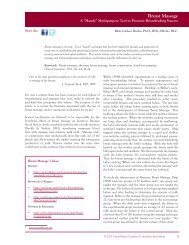Official Journal of the United States Lactation ... - Clinical Lactation
Official Journal of the United States Lactation ... - Clinical Lactation
Official Journal of the United States Lactation ... - Clinical Lactation
You also want an ePaper? Increase the reach of your titles
YUMPU automatically turns print PDFs into web optimized ePapers that Google loves.
<strong>the</strong> American Academy <strong>of</strong> Pediatrics recommends exclusive<br />
breastfeeding for six months, and at least one year <strong>of</strong><br />
continued breastfeeding.<br />
This is truly a beautiful DVD, and I highly recommend<br />
it to all pregnant mo<strong>the</strong>rs and <strong>the</strong>ir partners. As a health<br />
care provider, I also recommend it to all <strong>of</strong> us who counsel<br />
mo<strong>the</strong>rs about breastfeeding. This critical subject is<br />
presented in <strong>the</strong> most gentle, beautiful, calm way I have<br />
ever seen, and I think we would all learn from this<br />
approach. I can certainly see this video playing in waiting<br />
rooms where pregnant mo<strong>the</strong>rs are waiting for health<br />
care. What a beautiful picture to come away with!<br />
New Insights into Vitamin<br />
D during Pregnancy,<br />
<strong>Lactation</strong> and Early Infancy<br />
Carol L. Wagner, MD, with<br />
Sarah N. Taylor, MD, and Bruce<br />
W. Hollis, Ph.D. © 2010 Hale<br />
Publishing LP., Amarillo, TX,<br />
$24.95 USD<br />
www.ibreastfeeding.com<br />
Vitamin D is certainly a hot topic <strong>the</strong>se days; no pun<br />
intended. We hear about it everywhere, from medical<br />
practice to <strong>the</strong> daily news. It has been a controversial<br />
issue in breastfeeding for <strong>the</strong> last several decades—to supplement<br />
or not to supplement—is that <strong>the</strong> question<br />
As so eloquently elucidated in <strong>the</strong> book, New Insights Into<br />
Vitamin D During Pregnancy, <strong>Lactation</strong>, and Early Infancy,<br />
Drs. Wagner, Taylor, and Hollis take us on a journey <strong>of</strong><br />
our past, and current knowledge and understanding <strong>of</strong><br />
vitamin D, which is actually not a vitamin at all. As <strong>the</strong>y<br />
explain, vitamin D is a preprohormone that has pr<strong>of</strong>ound<br />
effects on metabolism and immune function<br />
extending far beyond purely bone and calcium metabolism.<br />
As <strong>the</strong>y state in <strong>the</strong> summary:<br />
Vitamin D is <strong>the</strong> substrate precursor to one <strong>of</strong> <strong>the</strong><br />
most powerful hormones in <strong>the</strong> body—1,25-dihydroxy-vitamin<br />
D, which has pr<strong>of</strong>ound effects on<br />
metabolism and immune function that extend<br />
far beyond <strong>the</strong> traditional thinking <strong>of</strong> bone and<br />
calcium metabolism. We are only just beginning<br />
to understand its effects on various organ systems<br />
throughout <strong>the</strong> body—from epidemiological studies<br />
to its action at <strong>the</strong> cellular level. Vitamin D<br />
had been linked to inflammatory and long-latency<br />
diseases, such as multiple sclerosis, rheumatoid<br />
arthritis, lupus, tuberculosis, diabetes, cardiovascular<br />
disease, and various cancers, to name a few.<br />
How can such a simple “vitamin” be involved<br />
in such diverse groups <strong>of</strong> diseases What is <strong>the</strong><br />
mechanism What does it mean to you as <strong>the</strong> individual,<br />
as <strong>the</strong> practitioner, or as <strong>the</strong> public policy<br />
maker (p. 7)<br />
They pack a tremendous amount <strong>of</strong> information into<br />
this 164-page s<strong>of</strong>t-cover book. We begin <strong>the</strong> journey with<br />
<strong>the</strong> history <strong>of</strong> vitamin D, its relationship to rickets, and<br />
its discovery as <strong>the</strong> active rickets-preventing component<br />
in cod liver oil. We are <strong>the</strong>n taken through <strong>the</strong> lifestyle<br />
changes that have led to widespread vitamin D deficiency<br />
throughout most populations, leading to one <strong>of</strong><br />
<strong>the</strong> largest nutrient deficiencies beginning in <strong>the</strong> late<br />
20 th century. As <strong>the</strong>y tell this “story,” it is fascinating to<br />
learn how we compounded this effect by our lack <strong>of</strong><br />
knowledge <strong>of</strong> <strong>the</strong> metabolism and function <strong>of</strong> this compound,<br />
thus setting forth recommendations that have<br />
now been associated with fur<strong>the</strong>ring <strong>the</strong> vitamin-D-deficiency<br />
state. Chapters are spent elucidating <strong>the</strong><br />
metabolism <strong>of</strong> vitamin D, its functions, and importantly,<br />
defining vitamin D sufficiency. This is accomplished<br />
using scientific data and research studies, pointing out<br />
those <strong>of</strong> quality and those with flaws that influenced our<br />
views—and thus our use, and misuse <strong>of</strong> vitamin D. And<br />
although some <strong>of</strong> <strong>the</strong> writing is quite technical, it is done<br />
in such a way that those among us without technical or<br />
chemistry backgrounds can easily follow and understand.<br />
Thus it bridges both worlds quite nicely: <strong>the</strong><br />
scientific-minded and those with interest, but possibly<br />
without <strong>the</strong> scientific background. As an MD, I “should”<br />
understand <strong>the</strong> science. But I must admit that when I<br />
start reading chemical formulations, I can easily drift <strong>of</strong>f.<br />
This book kept me riveted, focused, and interested as it<br />
is so well written.<br />
They go on to discuss vitamin D in <strong>the</strong> context <strong>of</strong> its<br />
various functions—bone mineralization, immune function—and<br />
how that knowledge influences our views on<br />
vitamin D requirements. We <strong>the</strong>n go on to learn about<br />
<strong>the</strong> effects <strong>of</strong> deficiency during pregnancy, lactation, and<br />
implications for early childhood and later adult life.<br />
There is a comprehensive discussion <strong>of</strong> <strong>the</strong> current controversies<br />
surrounding vitamin D supplementation, and<br />
what can be done by health care pr<strong>of</strong>essionals and public<br />
health <strong>of</strong>ficials to impact health care to prevent fur<strong>the</strong>r<br />
vitamin D deficiency.<br />
The final three chapters detail, with evidence presented<br />
© 2012 <strong>United</strong> <strong>States</strong> <strong>Lactation</strong> Consultant Association 37




